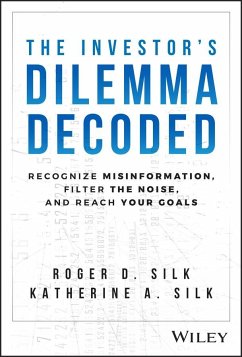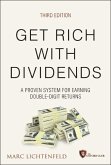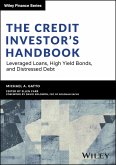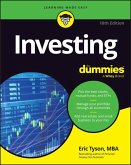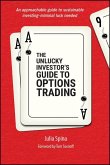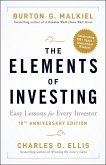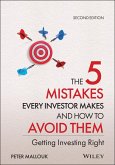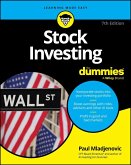Roger D. Silk, Katherine A. Silk
The Investor's Dilemma Decoded
Recognize Misinformation, Filter the Noise, and Reach Your Goals
23,99 €
inkl. MwSt.
Versandfertig in über 4 Wochen

12 °P sammeln
Roger D. Silk, Katherine A. Silk
The Investor's Dilemma Decoded
Recognize Misinformation, Filter the Noise, and Reach Your Goals
- Gebundenes Buch
- Merkliste
- Auf die Merkliste
- Bewerten Bewerten
- Teilen
- Produkt teilen
- Produkterinnerung
- Produkterinnerung
PRAISE FOR THE INVESTOR'S DILEMMA DECODED "Are you looking for a well-informed, logical approach to personal finance? If so, The Investor's Dilemma Decoded by Roger and Katherine Silk is the book for you. It is clear, accurate, and persuasive. Over the decades of your life, it could make the difference between mediocrity and comfort, and subpar returns vs. excellence." -TYLER COWEN, American economist and columnist, Professor, George Mason University "The Investor's Dilemma Decoded is extremely well written. One of the most thorough and comprehensive primers on investments. I highly recommend…mehr
Andere Kunden interessierten sich auch für
![Get Rich with Dividends Get Rich with Dividends]() Marc LichtenfeldGet Rich with Dividends31,99 €
Marc LichtenfeldGet Rich with Dividends31,99 €![The Credit Investor's Handbook The Credit Investor's Handbook]() Michael GattoThe Credit Investor's Handbook63,99 €
Michael GattoThe Credit Investor's Handbook63,99 €![Investing for Dummies Investing for Dummies]() Eric TysonInvesting for Dummies21,99 €
Eric TysonInvesting for Dummies21,99 €![The Unlucky Investor's Guide to Options Trading The Unlucky Investor's Guide to Options Trading]() Julia Spina (University of Illinois)The Unlucky Investor's Guide to Options Trading18,99 €
Julia Spina (University of Illinois)The Unlucky Investor's Guide to Options Trading18,99 €![The Elements of Investing The Elements of Investing]() Burton G. MalkielThe Elements of Investing17,99 €
Burton G. MalkielThe Elements of Investing17,99 €![The 5 Mistakes Every Investor Makes and How to Avoid Them The 5 Mistakes Every Investor Makes and How to Avoid Them]() Peter MalloukThe 5 Mistakes Every Investor Makes and How to Avoid Them23,99 €
Peter MalloukThe 5 Mistakes Every Investor Makes and How to Avoid Them23,99 €![Stock Investing for Dummies Stock Investing for Dummies]() Paul MladjenovicStock Investing for Dummies26,99 €
Paul MladjenovicStock Investing for Dummies26,99 €-
-
-
PRAISE FOR THE INVESTOR'S DILEMMA DECODED "Are you looking for a well-informed, logical approach to personal finance? If so, The Investor's Dilemma Decoded by Roger and Katherine Silk is the book for you. It is clear, accurate, and persuasive. Over the decades of your life, it could make the difference between mediocrity and comfort, and subpar returns vs. excellence." -TYLER COWEN, American economist and columnist, Professor, George Mason University "The Investor's Dilemma Decoded is extremely well written. One of the most thorough and comprehensive primers on investments. I highly recommend it to anyone who wants to raise their knowledge of investments." -THOMAS C . MYERS, CFA, CFP®, CPA, CEO and Senior Wealth Advisor, Bordeaux Wealth Advisors "Easy-to-understand, rock-solid explanation of how a variety of investment assets actually work. A great reference source for potential investors and financial planners alike." -BRUCE POPPER, CFP®, AEP®, CHFC®, Senior Estate Planning Consultant, Wealth Advisory Group "Anyone who is investing money or considering investing should read this book. Author Roger Silk's book is a 'playbook' for successful lifelong investing. The advice and counsel of a qualified financial advisor cannot be overstated." -JAMES A . "JIMMY" JACOBS, CLU®, CHFC®, President, Milestone Financial Solutions
Hinweis: Dieser Artikel kann nur an eine deutsche Lieferadresse ausgeliefert werden.
Hinweis: Dieser Artikel kann nur an eine deutsche Lieferadresse ausgeliefert werden.
Produktdetails
- Produktdetails
- Verlag: John Wiley & Sons Inc
- Seitenzahl: 368
- Erscheinungstermin: 2. April 2024
- Englisch
- Abmessung: 228mm x 158mm x 30mm
- Gewicht: 680g
- ISBN-13: 9781394220359
- ISBN-10: 1394220359
- Artikelnr.: 68358967
- Herstellerkennzeichnung
- Libri GmbH
- Europaallee 1
- 36244 Bad Hersfeld
- gpsr@libri.de
- Verlag: John Wiley & Sons Inc
- Seitenzahl: 368
- Erscheinungstermin: 2. April 2024
- Englisch
- Abmessung: 228mm x 158mm x 30mm
- Gewicht: 680g
- ISBN-13: 9781394220359
- ISBN-10: 1394220359
- Artikelnr.: 68358967
- Herstellerkennzeichnung
- Libri GmbH
- Europaallee 1
- 36244 Bad Hersfeld
- gpsr@libri.de
ROGER D. SILK holds a Ph.D. in applied economics from Stanford. He has served as CEO of Sterling Foundation Management since 1998. Silk earned his CFA in 1990 and has been writing about personal finance since then. He writes the highly respected blog Sterling Insights, and is the author of Politicians Spend, We Pay, and Managing Foundations and Charitable Trusts. KATHERINE A. SILK has an MA in history and BA in economics from Stanford. She was a management consultant prior to founding Strategic Startup Advisors. Silk is a frequent contributor to Sterling Insights blog.
Synopsis of The Investor's Dilemma Decoded xv
Acknowledgments xix
Introduction xxi
Chapter 1: Time Value of Money 1
The Standard Theory 1
Assumption: You Can Save Money at No Cost 2
Assumption: You Can Save Money at No Risk 3
Time Value of Money and Compound Growth 4
Comparing Values Across Time 6
Real-World Compounding Versus "Pure" Theory of Time Value of Money 6
Appendix 8
The Math of Compounding 8
More Frequent Compounding 8
Exercises 11
Answers 12
Chapter 2: Basic Investment Analysis 13
Basic Terminology 13
Modeling an Investment as a Series of Cash Flows 14
Net Present Value 15
Valuing a Stream of Cash Flows 17
Easy Way 18
Harder Way 18
Present Value of a Growing Perpetual Stream of Cash Flows 20
Duration: A Measure of Interest Rate Sensitivity 21
How Is Rate of Return Calculated? 23
Simple Annual Rate of Return Versus Compound Rate of Return 23
Arithmetic Versus Geometric Mean 24
Appendix 26
Internal Rate of Return 26
IRR Defined 26
Some Limitations of IRR 27
Chapter 3: Bonds/Fixed Income/Loans 31
Bonds 31
What Are Bonds? 31
Bond Terms 32
What Determines Bond Returns? 32
Return Versus Yield 33
Short to Medium Term 34
Inflation Adjusted or "Real" Returns 38
Risks to Bonds 41
Credit Risk 41
Historical Experience of Defaults 44
Interest Rate Risk 46
Bond Math - The Absolute Minimum 46
Inflation Risk 48
Low Interest Rates as Financial Repression 50
Chapter 4: Equities 51
What Are Equities? 51
Equity 52
Additional Equity or Equity-Like Asset Classes That Might Be of Interest 53
What Generates Stock Returns 53
Medium- and Short-Run Returns 55
Individual Stocks Versus "The Market" 56
Markets and Indices 56
Valuation Measures for Individual Companies 57
Valuation Changes and Returns 59
Noise - Information Versus Signal 60
Valuation Changes 61
Historic CAPE Versus Returns 61
What About Momentum? 62
What Has Generated Historical Returns in the US Market? 64
Long-Run Source of Returns to US Stocks 65
What Returns Can We Expect from US Stocks from Here? 66
Valuation Risk 69
Medium-Term Expected Returns 69
Variability 70
Takeaways Regarding Returns 72
Chapter 5: Real Estate 73
Kinds of Real Estate 74
Farmland 74
Falling Interest Rates Explain Half the Real Increase Since 1967 . . . 76
. . . But Falling Interest Rates Explain All the Real Increase Since 1987
76
Price/Earnings Ratio for Farmland 76
All Farmland 78
Farmland - Summary 80
Longer-Term Returns to Farmland 80
What Returns Should We Expect from Farmland? 84
Timber 85
Office Buildings 85
Returns to Land 86
Homes 88
Owning Apartments as Investments 90
Source of Return 90
Economic Theory 91
Summary 96
Chapter 6: Gold and Gold Stocks 99
Is Gold in a Class by Itself? 99
A Brief History of Gold 100
Gold's Place in a Portfolio 104
What About Gold Stocks? 106
Silver 107
Summary 108
Chapter 7: Futures and Commodities 111
Arbitrage 111
Futures Contracts 112
Pricing of Futures Contracts 113
Commodities 116
Monetary Regime Matters 122
Are There Commodity "Yields"? 123
Collateral Yield 126
Commodity Index Funds Have Negative Expected Real Returns 127
Managed Futures Funds 127
Barclays CTA Index 129
Chapter 8: Mutual Funds 133
Open-Ended Funds Versus Exchange Traded-Funds (ETFs) 133
Advantages of Fund Investing 134
Index Funds 134
Sector Funds 135
Hedge Funds 136
Individual Bonds Versus Bond Mutual Funds 136
Are Mutual Fund Expenses a Good Value? 137
Chapter 9: Basic Portfolio Theory 139
Markowitz Model 139
Capital Asset Pricing Model 142
How and Why Diversification Can Reduce Risk 143
Mathematical Underpinnings of the Capital Asset Pricing Model 144
Don't Mistake Beta (Returns Correlated with Risk) for Alpha (Risk-Free
Returns) 146
Assessing the Risks and Returns of the QQQ Versus the Spy 147
Drawdowns 149
Random Walk 150
Efficient Market Hypothesis 151
Significant Exception to the Efficient Market Hypothesis: The "Value
Anomaly" 154
Value Versus Growth Stocks 154
International Evidence 155
What About the "Size" Effect? 157
"Cheap" or "Expensive"? Volatility of Stock Prices Versus Earnings or
Dividends 158
Can You "Beat the Market"? 159
Why Don't Professionals Beat the Average? 160
Effect of Fees 160
Effect of Cash Holdings 160
Enhanced Index Strategies 161
Which Index? 163
Conclusion 164
Chapter 10: Financial Leverage 165
Reg. T. 166
Effect of Leverage 166
Securities Lending 169
Payments in Lieu of Dividends 169
Securities Lending Is a Complicated Tax Area 170
Rehypothecation Risk 171
Real World Leverage, Again 172
Chapter 11: Risk 175
Fear of Losing Money 175
Risk Versus Uncertainty 175
History 177
Using Statistics to Understand Risk 179
Explanation - Arithmetic and Geometric Means 179
So What? 181
Variance 182
Another Important Implication of Volatility 183
Modeling Likely Future Values 184
Modeling Future Wealth 184
Mathematical Approach - A Very Short Course in Statistics 185
Sample Mean 186
Standard Deviation 186
Population Standard Deviation Versus Sample Standard Deviation 188
Standard Error 188
Standard Error and DMS 189
Projecting the Likely Range of Future Values 190
Skewness 191
Percentiles 192
Expected Value Revisited 194
Chapter 12: Assembling a Portfolio 195
Forget About "Best" or "Optimal" 196
Reasonable Estimates for Expected Returns - Equities 197
Two Defensible Ways of Estimating Expected Returns 198
"Naïve" Long-Run Historical Average 198
Historical 201
Argument for Continued Outperformance 202
Argument Against Continued Outperformance 202
Role of Valuation 203
Valuation-Based Expected Return for Equities 203
Other Valuation Approaches 206
The Price/Book "Formula" 207
Expected Return 207
Our Preferred Methods 208
Reasonable Estimates for Expected Volatility 208
Time Frame 208
The VIX 209
Implied Versus Realized 210
The Case for 20% Long-Run Stock Market Volatility 211
Expected Returns and Volatility - Bonds 212
Expected Returns and Volatility - Cash 212
Expected Return and Volatility - Gold 213
Expected Return and Volatility - Gold Stocks 214
Expected Return and Volatility - Managed Futures 214
Cautions 216
Expected Returns and Volatility - Real Estate 218
Covariance Matrix 219
What Covariances/Correlations to Use 220
Covariances and Portfolio Formation 221
Stock Market Return Correlations Over Time 222
Calculating Expected Returns and Volatilities for a Multi-Asset Portfolio
225
Calculating the Return and Variance of a Portfolio 226
Return 226
Variance (Volatility) 226
Example with Six Assets 227
Matrix Algebra 228
Expected Returns 229
Variance 230
Chapter 13: Portfolio Simulations 233
Simulating a Variety of Portfolios Based on Cash and the World Equity
Market 233
Portfolio 0 235
Implications 243
Conclusion 246
Chapter 14: Professional Advice 247
Personal Financial Planners 248
Who Should Consider Professional Advice 248
Financial Literacy 249
FINRA's Quiz 249
Interpreting the FINRA Quiz 251
Numeracy 252
Aside on the Rule of 72 252
Financial Literacy and Professional Advice 253
How Professionals Add Value 254
How Much Value Financial Planners Add 255
Planner Value Added - "Gamma" 256
Factors to Consider When Selecting an Advisor 257
Alpha 258
Beta 258
Gamma 258
Advisor Characteristics 259
Integrity 259
Incentives 260
Skill 260
Personality 261
Checklist 263
Chapter 15: From Theory to Practice 265
Appendix: Some Math of Diversification 269
Variance 269
Standard Deviation 270
Examples Using Bet of Coin Flip with Positive Expected Value 271
Independent Events - The Key to Reducing Risk 273
Random Variables 274
Binomial Distribution 276
Normal Distribution 277
Covariance 278
Sum of Variances 279
Binomial Expansion 280
Weights 280
Variance of a Portfolio 281
Correlation Coefficient 281
Demonstration That If Assets Are Correlated, Risk Can Never Be Eliminated
282
How Much Diversification Is Enough? 283
Equal Weighting Versus Market Capitalization Weighting 285
Reasons to Prefer Equal Weighting 286
Theory 286
Market-Capitalization Weighting 288
Market-Cap Weighting and Statistical Bias 289
Diversification Within an Asset Class and Between Asset Classes 290
Within an Asset Class 290
Unified Asset Classes 290
Gold 290
Treasury Bills and Money Market Instruments 291
Sovereign Government Own-Fiat-Money Bonds 291
Dispersed Asset Classes 292
Bonds 292
Theoretical Example of Diversifying Bond Default Risk 292
Asymmetrical Risk 294
Stocks 294
Across How Many Stock Markets Should You Diversify? 294
How Stable Are the Parameters? 298
Conclusions: How Many Countries? 299
Statistical Normality 299
How Many Stocks Within a Country? 302
Median Expected Return 303
The Effect of Errors in Parameter Estimation 306
Error in Estimation 306
Another Point of View 307
Index 311
Three Free Offers for Readers 339
Acknowledgments xix
Introduction xxi
Chapter 1: Time Value of Money 1
The Standard Theory 1
Assumption: You Can Save Money at No Cost 2
Assumption: You Can Save Money at No Risk 3
Time Value of Money and Compound Growth 4
Comparing Values Across Time 6
Real-World Compounding Versus "Pure" Theory of Time Value of Money 6
Appendix 8
The Math of Compounding 8
More Frequent Compounding 8
Exercises 11
Answers 12
Chapter 2: Basic Investment Analysis 13
Basic Terminology 13
Modeling an Investment as a Series of Cash Flows 14
Net Present Value 15
Valuing a Stream of Cash Flows 17
Easy Way 18
Harder Way 18
Present Value of a Growing Perpetual Stream of Cash Flows 20
Duration: A Measure of Interest Rate Sensitivity 21
How Is Rate of Return Calculated? 23
Simple Annual Rate of Return Versus Compound Rate of Return 23
Arithmetic Versus Geometric Mean 24
Appendix 26
Internal Rate of Return 26
IRR Defined 26
Some Limitations of IRR 27
Chapter 3: Bonds/Fixed Income/Loans 31
Bonds 31
What Are Bonds? 31
Bond Terms 32
What Determines Bond Returns? 32
Return Versus Yield 33
Short to Medium Term 34
Inflation Adjusted or "Real" Returns 38
Risks to Bonds 41
Credit Risk 41
Historical Experience of Defaults 44
Interest Rate Risk 46
Bond Math - The Absolute Minimum 46
Inflation Risk 48
Low Interest Rates as Financial Repression 50
Chapter 4: Equities 51
What Are Equities? 51
Equity 52
Additional Equity or Equity-Like Asset Classes That Might Be of Interest 53
What Generates Stock Returns 53
Medium- and Short-Run Returns 55
Individual Stocks Versus "The Market" 56
Markets and Indices 56
Valuation Measures for Individual Companies 57
Valuation Changes and Returns 59
Noise - Information Versus Signal 60
Valuation Changes 61
Historic CAPE Versus Returns 61
What About Momentum? 62
What Has Generated Historical Returns in the US Market? 64
Long-Run Source of Returns to US Stocks 65
What Returns Can We Expect from US Stocks from Here? 66
Valuation Risk 69
Medium-Term Expected Returns 69
Variability 70
Takeaways Regarding Returns 72
Chapter 5: Real Estate 73
Kinds of Real Estate 74
Farmland 74
Falling Interest Rates Explain Half the Real Increase Since 1967 . . . 76
. . . But Falling Interest Rates Explain All the Real Increase Since 1987
76
Price/Earnings Ratio for Farmland 76
All Farmland 78
Farmland - Summary 80
Longer-Term Returns to Farmland 80
What Returns Should We Expect from Farmland? 84
Timber 85
Office Buildings 85
Returns to Land 86
Homes 88
Owning Apartments as Investments 90
Source of Return 90
Economic Theory 91
Summary 96
Chapter 6: Gold and Gold Stocks 99
Is Gold in a Class by Itself? 99
A Brief History of Gold 100
Gold's Place in a Portfolio 104
What About Gold Stocks? 106
Silver 107
Summary 108
Chapter 7: Futures and Commodities 111
Arbitrage 111
Futures Contracts 112
Pricing of Futures Contracts 113
Commodities 116
Monetary Regime Matters 122
Are There Commodity "Yields"? 123
Collateral Yield 126
Commodity Index Funds Have Negative Expected Real Returns 127
Managed Futures Funds 127
Barclays CTA Index 129
Chapter 8: Mutual Funds 133
Open-Ended Funds Versus Exchange Traded-Funds (ETFs) 133
Advantages of Fund Investing 134
Index Funds 134
Sector Funds 135
Hedge Funds 136
Individual Bonds Versus Bond Mutual Funds 136
Are Mutual Fund Expenses a Good Value? 137
Chapter 9: Basic Portfolio Theory 139
Markowitz Model 139
Capital Asset Pricing Model 142
How and Why Diversification Can Reduce Risk 143
Mathematical Underpinnings of the Capital Asset Pricing Model 144
Don't Mistake Beta (Returns Correlated with Risk) for Alpha (Risk-Free
Returns) 146
Assessing the Risks and Returns of the QQQ Versus the Spy 147
Drawdowns 149
Random Walk 150
Efficient Market Hypothesis 151
Significant Exception to the Efficient Market Hypothesis: The "Value
Anomaly" 154
Value Versus Growth Stocks 154
International Evidence 155
What About the "Size" Effect? 157
"Cheap" or "Expensive"? Volatility of Stock Prices Versus Earnings or
Dividends 158
Can You "Beat the Market"? 159
Why Don't Professionals Beat the Average? 160
Effect of Fees 160
Effect of Cash Holdings 160
Enhanced Index Strategies 161
Which Index? 163
Conclusion 164
Chapter 10: Financial Leverage 165
Reg. T. 166
Effect of Leverage 166
Securities Lending 169
Payments in Lieu of Dividends 169
Securities Lending Is a Complicated Tax Area 170
Rehypothecation Risk 171
Real World Leverage, Again 172
Chapter 11: Risk 175
Fear of Losing Money 175
Risk Versus Uncertainty 175
History 177
Using Statistics to Understand Risk 179
Explanation - Arithmetic and Geometric Means 179
So What? 181
Variance 182
Another Important Implication of Volatility 183
Modeling Likely Future Values 184
Modeling Future Wealth 184
Mathematical Approach - A Very Short Course in Statistics 185
Sample Mean 186
Standard Deviation 186
Population Standard Deviation Versus Sample Standard Deviation 188
Standard Error 188
Standard Error and DMS 189
Projecting the Likely Range of Future Values 190
Skewness 191
Percentiles 192
Expected Value Revisited 194
Chapter 12: Assembling a Portfolio 195
Forget About "Best" or "Optimal" 196
Reasonable Estimates for Expected Returns - Equities 197
Two Defensible Ways of Estimating Expected Returns 198
"Naïve" Long-Run Historical Average 198
Historical 201
Argument for Continued Outperformance 202
Argument Against Continued Outperformance 202
Role of Valuation 203
Valuation-Based Expected Return for Equities 203
Other Valuation Approaches 206
The Price/Book "Formula" 207
Expected Return 207
Our Preferred Methods 208
Reasonable Estimates for Expected Volatility 208
Time Frame 208
The VIX 209
Implied Versus Realized 210
The Case for 20% Long-Run Stock Market Volatility 211
Expected Returns and Volatility - Bonds 212
Expected Returns and Volatility - Cash 212
Expected Return and Volatility - Gold 213
Expected Return and Volatility - Gold Stocks 214
Expected Return and Volatility - Managed Futures 214
Cautions 216
Expected Returns and Volatility - Real Estate 218
Covariance Matrix 219
What Covariances/Correlations to Use 220
Covariances and Portfolio Formation 221
Stock Market Return Correlations Over Time 222
Calculating Expected Returns and Volatilities for a Multi-Asset Portfolio
225
Calculating the Return and Variance of a Portfolio 226
Return 226
Variance (Volatility) 226
Example with Six Assets 227
Matrix Algebra 228
Expected Returns 229
Variance 230
Chapter 13: Portfolio Simulations 233
Simulating a Variety of Portfolios Based on Cash and the World Equity
Market 233
Portfolio 0 235
Implications 243
Conclusion 246
Chapter 14: Professional Advice 247
Personal Financial Planners 248
Who Should Consider Professional Advice 248
Financial Literacy 249
FINRA's Quiz 249
Interpreting the FINRA Quiz 251
Numeracy 252
Aside on the Rule of 72 252
Financial Literacy and Professional Advice 253
How Professionals Add Value 254
How Much Value Financial Planners Add 255
Planner Value Added - "Gamma" 256
Factors to Consider When Selecting an Advisor 257
Alpha 258
Beta 258
Gamma 258
Advisor Characteristics 259
Integrity 259
Incentives 260
Skill 260
Personality 261
Checklist 263
Chapter 15: From Theory to Practice 265
Appendix: Some Math of Diversification 269
Variance 269
Standard Deviation 270
Examples Using Bet of Coin Flip with Positive Expected Value 271
Independent Events - The Key to Reducing Risk 273
Random Variables 274
Binomial Distribution 276
Normal Distribution 277
Covariance 278
Sum of Variances 279
Binomial Expansion 280
Weights 280
Variance of a Portfolio 281
Correlation Coefficient 281
Demonstration That If Assets Are Correlated, Risk Can Never Be Eliminated
282
How Much Diversification Is Enough? 283
Equal Weighting Versus Market Capitalization Weighting 285
Reasons to Prefer Equal Weighting 286
Theory 286
Market-Capitalization Weighting 288
Market-Cap Weighting and Statistical Bias 289
Diversification Within an Asset Class and Between Asset Classes 290
Within an Asset Class 290
Unified Asset Classes 290
Gold 290
Treasury Bills and Money Market Instruments 291
Sovereign Government Own-Fiat-Money Bonds 291
Dispersed Asset Classes 292
Bonds 292
Theoretical Example of Diversifying Bond Default Risk 292
Asymmetrical Risk 294
Stocks 294
Across How Many Stock Markets Should You Diversify? 294
How Stable Are the Parameters? 298
Conclusions: How Many Countries? 299
Statistical Normality 299
How Many Stocks Within a Country? 302
Median Expected Return 303
The Effect of Errors in Parameter Estimation 306
Error in Estimation 306
Another Point of View 307
Index 311
Three Free Offers for Readers 339
Synopsis of The Investor's Dilemma Decoded xv
Acknowledgments xix
Introduction xxi
Chapter 1: Time Value of Money 1
The Standard Theory 1
Assumption: You Can Save Money at No Cost 2
Assumption: You Can Save Money at No Risk 3
Time Value of Money and Compound Growth 4
Comparing Values Across Time 6
Real-World Compounding Versus "Pure" Theory of Time Value of Money 6
Appendix 8
The Math of Compounding 8
More Frequent Compounding 8
Exercises 11
Answers 12
Chapter 2: Basic Investment Analysis 13
Basic Terminology 13
Modeling an Investment as a Series of Cash Flows 14
Net Present Value 15
Valuing a Stream of Cash Flows 17
Easy Way 18
Harder Way 18
Present Value of a Growing Perpetual Stream of Cash Flows 20
Duration: A Measure of Interest Rate Sensitivity 21
How Is Rate of Return Calculated? 23
Simple Annual Rate of Return Versus Compound Rate of Return 23
Arithmetic Versus Geometric Mean 24
Appendix 26
Internal Rate of Return 26
IRR Defined 26
Some Limitations of IRR 27
Chapter 3: Bonds/Fixed Income/Loans 31
Bonds 31
What Are Bonds? 31
Bond Terms 32
What Determines Bond Returns? 32
Return Versus Yield 33
Short to Medium Term 34
Inflation Adjusted or "Real" Returns 38
Risks to Bonds 41
Credit Risk 41
Historical Experience of Defaults 44
Interest Rate Risk 46
Bond Math - The Absolute Minimum 46
Inflation Risk 48
Low Interest Rates as Financial Repression 50
Chapter 4: Equities 51
What Are Equities? 51
Equity 52
Additional Equity or Equity-Like Asset Classes That Might Be of Interest 53
What Generates Stock Returns 53
Medium- and Short-Run Returns 55
Individual Stocks Versus "The Market" 56
Markets and Indices 56
Valuation Measures for Individual Companies 57
Valuation Changes and Returns 59
Noise - Information Versus Signal 60
Valuation Changes 61
Historic CAPE Versus Returns 61
What About Momentum? 62
What Has Generated Historical Returns in the US Market? 64
Long-Run Source of Returns to US Stocks 65
What Returns Can We Expect from US Stocks from Here? 66
Valuation Risk 69
Medium-Term Expected Returns 69
Variability 70
Takeaways Regarding Returns 72
Chapter 5: Real Estate 73
Kinds of Real Estate 74
Farmland 74
Falling Interest Rates Explain Half the Real Increase Since 1967 . . . 76
. . . But Falling Interest Rates Explain All the Real Increase Since 1987
76
Price/Earnings Ratio for Farmland 76
All Farmland 78
Farmland - Summary 80
Longer-Term Returns to Farmland 80
What Returns Should We Expect from Farmland? 84
Timber 85
Office Buildings 85
Returns to Land 86
Homes 88
Owning Apartments as Investments 90
Source of Return 90
Economic Theory 91
Summary 96
Chapter 6: Gold and Gold Stocks 99
Is Gold in a Class by Itself? 99
A Brief History of Gold 100
Gold's Place in a Portfolio 104
What About Gold Stocks? 106
Silver 107
Summary 108
Chapter 7: Futures and Commodities 111
Arbitrage 111
Futures Contracts 112
Pricing of Futures Contracts 113
Commodities 116
Monetary Regime Matters 122
Are There Commodity "Yields"? 123
Collateral Yield 126
Commodity Index Funds Have Negative Expected Real Returns 127
Managed Futures Funds 127
Barclays CTA Index 129
Chapter 8: Mutual Funds 133
Open-Ended Funds Versus Exchange Traded-Funds (ETFs) 133
Advantages of Fund Investing 134
Index Funds 134
Sector Funds 135
Hedge Funds 136
Individual Bonds Versus Bond Mutual Funds 136
Are Mutual Fund Expenses a Good Value? 137
Chapter 9: Basic Portfolio Theory 139
Markowitz Model 139
Capital Asset Pricing Model 142
How and Why Diversification Can Reduce Risk 143
Mathematical Underpinnings of the Capital Asset Pricing Model 144
Don't Mistake Beta (Returns Correlated with Risk) for Alpha (Risk-Free
Returns) 146
Assessing the Risks and Returns of the QQQ Versus the Spy 147
Drawdowns 149
Random Walk 150
Efficient Market Hypothesis 151
Significant Exception to the Efficient Market Hypothesis: The "Value
Anomaly" 154
Value Versus Growth Stocks 154
International Evidence 155
What About the "Size" Effect? 157
"Cheap" or "Expensive"? Volatility of Stock Prices Versus Earnings or
Dividends 158
Can You "Beat the Market"? 159
Why Don't Professionals Beat the Average? 160
Effect of Fees 160
Effect of Cash Holdings 160
Enhanced Index Strategies 161
Which Index? 163
Conclusion 164
Chapter 10: Financial Leverage 165
Reg. T. 166
Effect of Leverage 166
Securities Lending 169
Payments in Lieu of Dividends 169
Securities Lending Is a Complicated Tax Area 170
Rehypothecation Risk 171
Real World Leverage, Again 172
Chapter 11: Risk 175
Fear of Losing Money 175
Risk Versus Uncertainty 175
History 177
Using Statistics to Understand Risk 179
Explanation - Arithmetic and Geometric Means 179
So What? 181
Variance 182
Another Important Implication of Volatility 183
Modeling Likely Future Values 184
Modeling Future Wealth 184
Mathematical Approach - A Very Short Course in Statistics 185
Sample Mean 186
Standard Deviation 186
Population Standard Deviation Versus Sample Standard Deviation 188
Standard Error 188
Standard Error and DMS 189
Projecting the Likely Range of Future Values 190
Skewness 191
Percentiles 192
Expected Value Revisited 194
Chapter 12: Assembling a Portfolio 195
Forget About "Best" or "Optimal" 196
Reasonable Estimates for Expected Returns - Equities 197
Two Defensible Ways of Estimating Expected Returns 198
"Naïve" Long-Run Historical Average 198
Historical 201
Argument for Continued Outperformance 202
Argument Against Continued Outperformance 202
Role of Valuation 203
Valuation-Based Expected Return for Equities 203
Other Valuation Approaches 206
The Price/Book "Formula" 207
Expected Return 207
Our Preferred Methods 208
Reasonable Estimates for Expected Volatility 208
Time Frame 208
The VIX 209
Implied Versus Realized 210
The Case for 20% Long-Run Stock Market Volatility 211
Expected Returns and Volatility - Bonds 212
Expected Returns and Volatility - Cash 212
Expected Return and Volatility - Gold 213
Expected Return and Volatility - Gold Stocks 214
Expected Return and Volatility - Managed Futures 214
Cautions 216
Expected Returns and Volatility - Real Estate 218
Covariance Matrix 219
What Covariances/Correlations to Use 220
Covariances and Portfolio Formation 221
Stock Market Return Correlations Over Time 222
Calculating Expected Returns and Volatilities for a Multi-Asset Portfolio
225
Calculating the Return and Variance of a Portfolio 226
Return 226
Variance (Volatility) 226
Example with Six Assets 227
Matrix Algebra 228
Expected Returns 229
Variance 230
Chapter 13: Portfolio Simulations 233
Simulating a Variety of Portfolios Based on Cash and the World Equity
Market 233
Portfolio 0 235
Implications 243
Conclusion 246
Chapter 14: Professional Advice 247
Personal Financial Planners 248
Who Should Consider Professional Advice 248
Financial Literacy 249
FINRA's Quiz 249
Interpreting the FINRA Quiz 251
Numeracy 252
Aside on the Rule of 72 252
Financial Literacy and Professional Advice 253
How Professionals Add Value 254
How Much Value Financial Planners Add 255
Planner Value Added - "Gamma" 256
Factors to Consider When Selecting an Advisor 257
Alpha 258
Beta 258
Gamma 258
Advisor Characteristics 259
Integrity 259
Incentives 260
Skill 260
Personality 261
Checklist 263
Chapter 15: From Theory to Practice 265
Appendix: Some Math of Diversification 269
Variance 269
Standard Deviation 270
Examples Using Bet of Coin Flip with Positive Expected Value 271
Independent Events - The Key to Reducing Risk 273
Random Variables 274
Binomial Distribution 276
Normal Distribution 277
Covariance 278
Sum of Variances 279
Binomial Expansion 280
Weights 280
Variance of a Portfolio 281
Correlation Coefficient 281
Demonstration That If Assets Are Correlated, Risk Can Never Be Eliminated
282
How Much Diversification Is Enough? 283
Equal Weighting Versus Market Capitalization Weighting 285
Reasons to Prefer Equal Weighting 286
Theory 286
Market-Capitalization Weighting 288
Market-Cap Weighting and Statistical Bias 289
Diversification Within an Asset Class and Between Asset Classes 290
Within an Asset Class 290
Unified Asset Classes 290
Gold 290
Treasury Bills and Money Market Instruments 291
Sovereign Government Own-Fiat-Money Bonds 291
Dispersed Asset Classes 292
Bonds 292
Theoretical Example of Diversifying Bond Default Risk 292
Asymmetrical Risk 294
Stocks 294
Across How Many Stock Markets Should You Diversify? 294
How Stable Are the Parameters? 298
Conclusions: How Many Countries? 299
Statistical Normality 299
How Many Stocks Within a Country? 302
Median Expected Return 303
The Effect of Errors in Parameter Estimation 306
Error in Estimation 306
Another Point of View 307
Index 311
Three Free Offers for Readers 339
Acknowledgments xix
Introduction xxi
Chapter 1: Time Value of Money 1
The Standard Theory 1
Assumption: You Can Save Money at No Cost 2
Assumption: You Can Save Money at No Risk 3
Time Value of Money and Compound Growth 4
Comparing Values Across Time 6
Real-World Compounding Versus "Pure" Theory of Time Value of Money 6
Appendix 8
The Math of Compounding 8
More Frequent Compounding 8
Exercises 11
Answers 12
Chapter 2: Basic Investment Analysis 13
Basic Terminology 13
Modeling an Investment as a Series of Cash Flows 14
Net Present Value 15
Valuing a Stream of Cash Flows 17
Easy Way 18
Harder Way 18
Present Value of a Growing Perpetual Stream of Cash Flows 20
Duration: A Measure of Interest Rate Sensitivity 21
How Is Rate of Return Calculated? 23
Simple Annual Rate of Return Versus Compound Rate of Return 23
Arithmetic Versus Geometric Mean 24
Appendix 26
Internal Rate of Return 26
IRR Defined 26
Some Limitations of IRR 27
Chapter 3: Bonds/Fixed Income/Loans 31
Bonds 31
What Are Bonds? 31
Bond Terms 32
What Determines Bond Returns? 32
Return Versus Yield 33
Short to Medium Term 34
Inflation Adjusted or "Real" Returns 38
Risks to Bonds 41
Credit Risk 41
Historical Experience of Defaults 44
Interest Rate Risk 46
Bond Math - The Absolute Minimum 46
Inflation Risk 48
Low Interest Rates as Financial Repression 50
Chapter 4: Equities 51
What Are Equities? 51
Equity 52
Additional Equity or Equity-Like Asset Classes That Might Be of Interest 53
What Generates Stock Returns 53
Medium- and Short-Run Returns 55
Individual Stocks Versus "The Market" 56
Markets and Indices 56
Valuation Measures for Individual Companies 57
Valuation Changes and Returns 59
Noise - Information Versus Signal 60
Valuation Changes 61
Historic CAPE Versus Returns 61
What About Momentum? 62
What Has Generated Historical Returns in the US Market? 64
Long-Run Source of Returns to US Stocks 65
What Returns Can We Expect from US Stocks from Here? 66
Valuation Risk 69
Medium-Term Expected Returns 69
Variability 70
Takeaways Regarding Returns 72
Chapter 5: Real Estate 73
Kinds of Real Estate 74
Farmland 74
Falling Interest Rates Explain Half the Real Increase Since 1967 . . . 76
. . . But Falling Interest Rates Explain All the Real Increase Since 1987
76
Price/Earnings Ratio for Farmland 76
All Farmland 78
Farmland - Summary 80
Longer-Term Returns to Farmland 80
What Returns Should We Expect from Farmland? 84
Timber 85
Office Buildings 85
Returns to Land 86
Homes 88
Owning Apartments as Investments 90
Source of Return 90
Economic Theory 91
Summary 96
Chapter 6: Gold and Gold Stocks 99
Is Gold in a Class by Itself? 99
A Brief History of Gold 100
Gold's Place in a Portfolio 104
What About Gold Stocks? 106
Silver 107
Summary 108
Chapter 7: Futures and Commodities 111
Arbitrage 111
Futures Contracts 112
Pricing of Futures Contracts 113
Commodities 116
Monetary Regime Matters 122
Are There Commodity "Yields"? 123
Collateral Yield 126
Commodity Index Funds Have Negative Expected Real Returns 127
Managed Futures Funds 127
Barclays CTA Index 129
Chapter 8: Mutual Funds 133
Open-Ended Funds Versus Exchange Traded-Funds (ETFs) 133
Advantages of Fund Investing 134
Index Funds 134
Sector Funds 135
Hedge Funds 136
Individual Bonds Versus Bond Mutual Funds 136
Are Mutual Fund Expenses a Good Value? 137
Chapter 9: Basic Portfolio Theory 139
Markowitz Model 139
Capital Asset Pricing Model 142
How and Why Diversification Can Reduce Risk 143
Mathematical Underpinnings of the Capital Asset Pricing Model 144
Don't Mistake Beta (Returns Correlated with Risk) for Alpha (Risk-Free
Returns) 146
Assessing the Risks and Returns of the QQQ Versus the Spy 147
Drawdowns 149
Random Walk 150
Efficient Market Hypothesis 151
Significant Exception to the Efficient Market Hypothesis: The "Value
Anomaly" 154
Value Versus Growth Stocks 154
International Evidence 155
What About the "Size" Effect? 157
"Cheap" or "Expensive"? Volatility of Stock Prices Versus Earnings or
Dividends 158
Can You "Beat the Market"? 159
Why Don't Professionals Beat the Average? 160
Effect of Fees 160
Effect of Cash Holdings 160
Enhanced Index Strategies 161
Which Index? 163
Conclusion 164
Chapter 10: Financial Leverage 165
Reg. T. 166
Effect of Leverage 166
Securities Lending 169
Payments in Lieu of Dividends 169
Securities Lending Is a Complicated Tax Area 170
Rehypothecation Risk 171
Real World Leverage, Again 172
Chapter 11: Risk 175
Fear of Losing Money 175
Risk Versus Uncertainty 175
History 177
Using Statistics to Understand Risk 179
Explanation - Arithmetic and Geometric Means 179
So What? 181
Variance 182
Another Important Implication of Volatility 183
Modeling Likely Future Values 184
Modeling Future Wealth 184
Mathematical Approach - A Very Short Course in Statistics 185
Sample Mean 186
Standard Deviation 186
Population Standard Deviation Versus Sample Standard Deviation 188
Standard Error 188
Standard Error and DMS 189
Projecting the Likely Range of Future Values 190
Skewness 191
Percentiles 192
Expected Value Revisited 194
Chapter 12: Assembling a Portfolio 195
Forget About "Best" or "Optimal" 196
Reasonable Estimates for Expected Returns - Equities 197
Two Defensible Ways of Estimating Expected Returns 198
"Naïve" Long-Run Historical Average 198
Historical 201
Argument for Continued Outperformance 202
Argument Against Continued Outperformance 202
Role of Valuation 203
Valuation-Based Expected Return for Equities 203
Other Valuation Approaches 206
The Price/Book "Formula" 207
Expected Return 207
Our Preferred Methods 208
Reasonable Estimates for Expected Volatility 208
Time Frame 208
The VIX 209
Implied Versus Realized 210
The Case for 20% Long-Run Stock Market Volatility 211
Expected Returns and Volatility - Bonds 212
Expected Returns and Volatility - Cash 212
Expected Return and Volatility - Gold 213
Expected Return and Volatility - Gold Stocks 214
Expected Return and Volatility - Managed Futures 214
Cautions 216
Expected Returns and Volatility - Real Estate 218
Covariance Matrix 219
What Covariances/Correlations to Use 220
Covariances and Portfolio Formation 221
Stock Market Return Correlations Over Time 222
Calculating Expected Returns and Volatilities for a Multi-Asset Portfolio
225
Calculating the Return and Variance of a Portfolio 226
Return 226
Variance (Volatility) 226
Example with Six Assets 227
Matrix Algebra 228
Expected Returns 229
Variance 230
Chapter 13: Portfolio Simulations 233
Simulating a Variety of Portfolios Based on Cash and the World Equity
Market 233
Portfolio 0 235
Implications 243
Conclusion 246
Chapter 14: Professional Advice 247
Personal Financial Planners 248
Who Should Consider Professional Advice 248
Financial Literacy 249
FINRA's Quiz 249
Interpreting the FINRA Quiz 251
Numeracy 252
Aside on the Rule of 72 252
Financial Literacy and Professional Advice 253
How Professionals Add Value 254
How Much Value Financial Planners Add 255
Planner Value Added - "Gamma" 256
Factors to Consider When Selecting an Advisor 257
Alpha 258
Beta 258
Gamma 258
Advisor Characteristics 259
Integrity 259
Incentives 260
Skill 260
Personality 261
Checklist 263
Chapter 15: From Theory to Practice 265
Appendix: Some Math of Diversification 269
Variance 269
Standard Deviation 270
Examples Using Bet of Coin Flip with Positive Expected Value 271
Independent Events - The Key to Reducing Risk 273
Random Variables 274
Binomial Distribution 276
Normal Distribution 277
Covariance 278
Sum of Variances 279
Binomial Expansion 280
Weights 280
Variance of a Portfolio 281
Correlation Coefficient 281
Demonstration That If Assets Are Correlated, Risk Can Never Be Eliminated
282
How Much Diversification Is Enough? 283
Equal Weighting Versus Market Capitalization Weighting 285
Reasons to Prefer Equal Weighting 286
Theory 286
Market-Capitalization Weighting 288
Market-Cap Weighting and Statistical Bias 289
Diversification Within an Asset Class and Between Asset Classes 290
Within an Asset Class 290
Unified Asset Classes 290
Gold 290
Treasury Bills and Money Market Instruments 291
Sovereign Government Own-Fiat-Money Bonds 291
Dispersed Asset Classes 292
Bonds 292
Theoretical Example of Diversifying Bond Default Risk 292
Asymmetrical Risk 294
Stocks 294
Across How Many Stock Markets Should You Diversify? 294
How Stable Are the Parameters? 298
Conclusions: How Many Countries? 299
Statistical Normality 299
How Many Stocks Within a Country? 302
Median Expected Return 303
The Effect of Errors in Parameter Estimation 306
Error in Estimation 306
Another Point of View 307
Index 311
Three Free Offers for Readers 339
